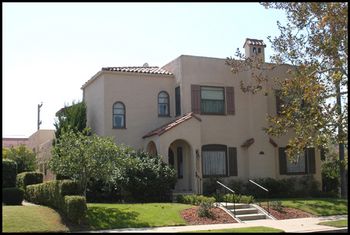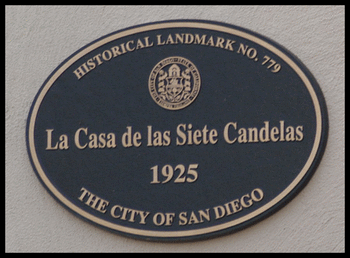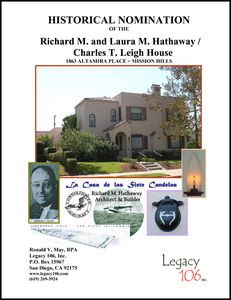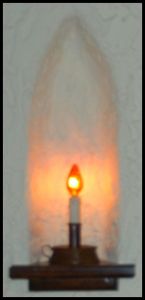|
|
 |
|
|
Historical Landmark No. 779 Mission Hills Community Historical Landmark No. 779 - Designated September 2006 |
|
|
| ||
|
|
| ||
|
|
One of Hathaway’s homes has already been designated City of San Diego Historical Landmark, No. 600, at 1833 Altamira Place. It is called the “Hathaway Spec House No. 1” and was designated by the Historical Resources Board for its Architecture on July 31, 2003. Ironically, all four adjacent houses are related, as the Hathaways owned and lived in the big Craftsman house situated between the three Hathaway-built houses while their corner house was under construction. Although 1833 is now called “Spec House No. 1” in actuality it was the last of the three he built. | ||
|
|
The house is important for its architecture and association with one historical resident. For a short period during the Great Depression Charles T. and Helen Leigh rented the house. Charles was a vice president of the Consolidated Aircraft Corporation and played a major role in the construction of the first plant located on Pacific Highway. Major Rueben Fleet brought Leigh to San Diego to take charge of the construction of this important facility and Leigh and his family lived in the house during the construction of the new plant. In 1935, Ruben H. Fleet, president and manager of Consolidated Aircraft Corporation brought his new airplane manufacturing operation to San Diego from Buffalo, New York. The new home for this important industry was Lindbergh Field, then considered one of the finest airports in the country, outranking many eastern airports for its ease of access. Fleet had won a naval contract for 110 planes, which required construction of a new west coast plant. He brought 162 key employees and their families to San Diego and closed his Buffalo, N.Y. plant. | ||
|
|
In 1921, Fleet had brought Leigh to Buffalo to supervise the construction of an addition to Fleet’s New York airplane manufacturing plant. In 1935, Fleet again tasked Leigh to supervise the construction of the first Consolidated Aircraft Corporation plant in San Diego, which was located on Pacific Highway at Lindbergh Field. Leigh was Fleet’s materials supervisor and a vice president. Leigh and his family moved into this house that year. On October 20, 1935, the opening day of the new plant, the San Diego Union listed Leigh among the “Prominent Men in Aviation Direct Affairs of Plane Factory Here; Many of the best known men in aviation are officers and directors of Consolidated Aircraft Corp, whose new plant will be opened formally at Lindbergh field today.” The plant provided a boom to San Diego’s economy, with new jobs being added each month until they reached their target of 2500 employees and a monthly payroll of $400,000. The headlines read “Big Plane Factory Boosts City’s Progress” and the plant was instrumental in contributing to San Diego’s reputation as “the Air Capital of the West.” | |
|
|
Richard M. Hathaway was born April 29, 1883 in Portland, Michigan to Belle Scribner Hathaway and Frederick Crawford Hathaway. He married Laura May Smith, also of Portland, Michigan, on June 28, 1911 and they had one son, Richard Smith. Laura was born in 1886 and her mother’s maiden name was Gale (U.S. Census 1930). When the Hathaways moved into Mission Hills in 1921, Richard was an ambitious 38-year-old veteran. He had served in World War I and had helped in the construction of the Panama Canal. He had a background in art, which expressed itself in career experience in jewelry, watch, clock, and furniture manufacturing as well as gold and copper plate engraving. He received his art training first in Detroit and then at a branch of New York University. He also had experience in construction and automobile manufacturing. | |
|
|
His knowledge of steel and concrete construction helped him when he worked with the Panama Canal project. Later he worked in Detroit, with the Michigan district of the United States Ordnance Department where was in charge of the inspection and production of ordnance materials. He was an experienced draftsman with experience in architecture, sales, and advertising. The 1928-1929 Who’s Who listing indicates that he had been an architect, but by that year he had already retired. In the 1920s he would also list “investments,” “real estate,” and “builder” to his list of professions. The U.S. Census information is not clear as to where the Hathaways lived in 1920 or what served as their occupations, but it is known that they came to San Diego by 1921. Later census records did not record any occupation for Laura, and her activities and interests remain virtually unrecorded in the historical documents. Meanwhile, the facts show that Richard involved himself with organizations and associations that could help his business interests in San Diego. He had joined the Masons while living in Detroit and by 1928 he was a 32nd degree Mason and a member of the Shriners. He was a Protestant by faith and Republican in politics. For recreation he had joined the San Diego Athletic Club, Country Club, and Yacht Club. He also joined the Cuyamaca Club and was a member of the Fine Arts Society. By 1921, Richard appears to have been ready to launch right away into business for himself. The 1921 directory listed “real estate” as his profession but he was not cross list in the Classified section. By 1922, he had formed R.M. Hathaway Investments (still no Articles of Incorporation) and set up his first office at 220 Owl Drug Building, 1025 4th Avenue. Two years later in 1924, he relocated to room 539 in the Spreckels Building at 121 Broadway (Directory 1924). | |
|
|
Permission to use this material is granted provided it is attributed as follows: Copyright © 2010 Ronald V. May and Dale Ballou May, Legacy 106, Inc., www.legacy106.com | |
|
|
Home | Designations | Qualifications | Company Profile | Newsletter | Links Archaeology
& Historic Preservation www.legacy106.com |
|






